
Based on my informal assessments and evaluations of the current practices and results of the education system in Nepal, which has been providing education to the public only for the last seventy years or so, I can say that the system has failed and continues to fail a large percentage of the population of the country. Evidences abound but here’s one: the poets whose poems are included in a poetry textbook for primary school children. The analysis of the contents of the Grade 4 poetry textbook, Chhandako Chhahara, also, indirectly, reaffirms the structural issues the country suffers from. Annie Shrestha, a volunteer, assisted me with the analysis.
As you can tell (see image below), Rato Bangala Kitab is the publisher.

This one is the 5th edition, published three years ago (2076 BS). The 1st Edition came out in 2062 BS, seventeen years ago.
Click here, here, and here for the images of the table of contents of the textbook. The first column is the serial number. The second, third, and fourth columns list the titles, the full name of the poet/poetess, and the page respectively. It contains 108 poems written by 66 poets representing only 44 surnames. Let’s analyze them further.
First, a breakdown of the poems by ethnicity/caste of the poet and their comparison to the population.

As you can see, 88% — disproportionately high percentage — of the poets belong to the Bahun/Brahmin ethnicity (the so-called high caste). That’s over seven times more representation than their proportion in the population. If you think this is bad, wait until you see the rest of the analysis.
Incidentally, the “indeterminate” are those whose caste could NOT be ascertained from their surname. Here’s their list.

Any bets that they are ALL Bahun/Brahmin?
Next, a breakdown of the poems by the gender of the poets (see chart below). Only three were by females.
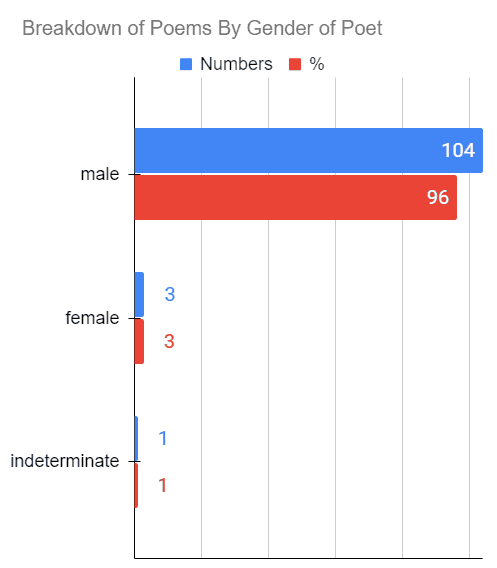
According to the 2011 Census Report, ~51% of the population are female. So, were the poets representative of the gender make-up of population, 54 poems would have been by females.
Here’s a further breakdown of the poems by ethnicity/caste of the female poets and their comparison to the population. (The gender proportion in the population, red in the chart below, were determined by assuming them to be half of the total proportion and so not completely accurate but good enough for the purpose.)
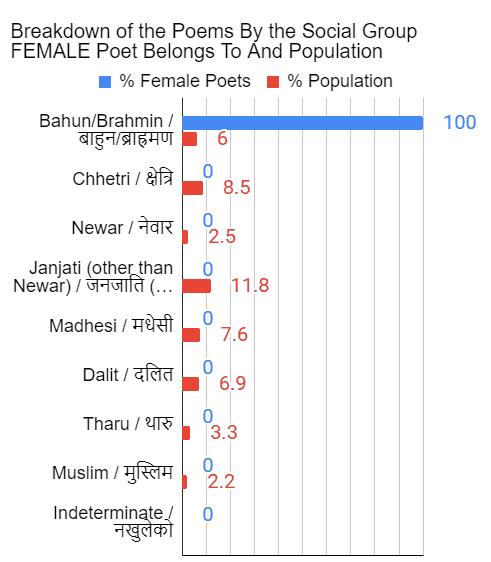
Yup, every single one came from one ethnicity! Here are their names, including that of the one whose gender could NOT be ascertained from their name.

Let’s have a look at the poems by the male poets. Here’s their breakdown by the poet’s ethnicity/caste.
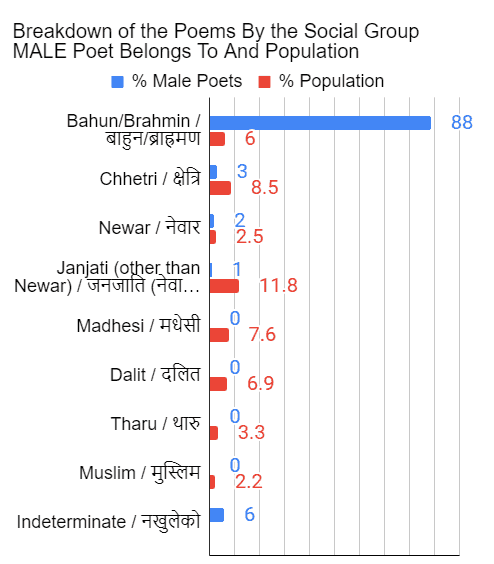
A VAST MAJORITY (88%) of the poems were by Bahun/Brahmin men! As matter of fact, their representation is so disproportionately high that they are represented almost 15 times their proportion in the population. And that’s NOT the worst…still!
But before that, even though the book contained 108 poems, they represented the outputs from only 66 poets. That is, many poets had multiple poems included in the book. Here are the poets three or more of whose poems were found. What do you notice?

Here something else that’s worse, but still NOT the worst! The 66 poets — whose 108 works were included in the book — represented just 44 different surnames. Here are the surnames broken down by those with three or more poems in the book.
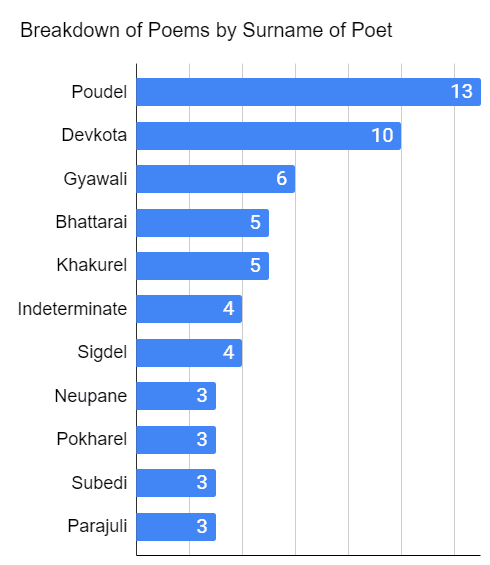
I wasn’t able to find a reliable source for the number of surnames that exist in Nepal. But one source put it at over 3000. Assuming 3000, here’s a pie chart breaking down the poets by surname.

Yup, the number of surnames represented is just 1.6%!
Another source put the number of surnames to only 714. Here’s how the representation of surnames looks like in this case.
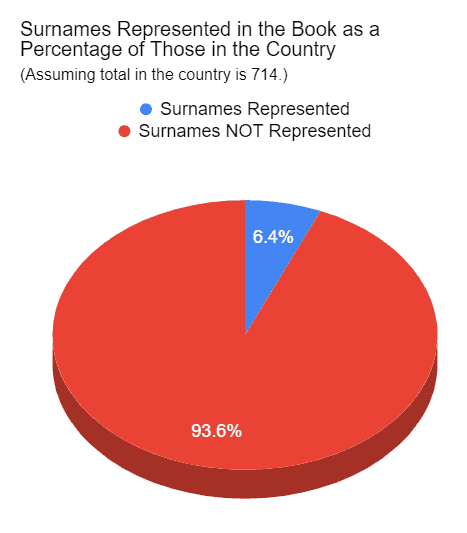
Only 6.4% were represented. That is only 1 in 16 surnames were represented in the textbook!
Here, finally, is the worst! According to the 2011 Census Report, there are 126 ethnic groups in the country (see chart below).

ASSUMING Bahun/Brahmin to be an “ethnic” group, a vast majority of the poems were works of only ONE of the 126 ethnic groups. In other words, 88% were by only 0.8% of ethnic groups! So, the most represented ethnic group in the textbook is represented 100 times their proportion in the population!
So what’s the problem with all that?
Education to the public in Nepal has been available for only around the last 70 years. The progress we have been making has been slow, painfully slow. We still haven’t reached even close to 100% literacy. See the chart below for the progress over the decades.

The literacy rate according to the 1952/54 Census Report was 5.3. By 2011, that had reached 65.9. That’s 60.6% increase in 57 years, which works out to approximately ONLY 1% per year rise!
As for the level of education of the population, according to the 2011 Census Report, it’s abysmal: less than 10% of the population have twelve or more years of education.

As if not achieving 100% literacy even by now was NOT bad enough, as if the abysmal level of education of the population was NOT bad enough — the results of the analysis of Chhandako Chhahara HINTS at our education system being flawed and provides further evidence for the warped structures in the country. Is it and are they?
Let’s consider the questions from the perspective of the publisher. Hardly knowing anything about the team involved in the selection and compilation of the poems, of course, I can’t say anything concrete.
But, let’s assume that the publisher had a capable, diligent, and diverse team behind that when it was published in 2062 BS (2005-06 AD). If indeed that was the best they could do with the anthology in terms of diversity in the representations of poets, then, indeed, our education system post-1950 likely has educated mostly Bahun/Brahmin MEN and/or mostly them sufficiently well to make them worthwhile poets.
I have yet to see recent educational achievements by caste or ethnicity (which is NOT to say it might NOT exist), but Human Development Index scores indirectly reveals that. Those with the highest scores, according to the 2011 report (see below), are the hill so-called high caste Hindus, the Madhesi Brahman/Chettri, and the Newars.

Going farther back, in From Exclusion to Inclusion: Socio-Political Agenda for Nepal, Dr. Harka Bahadur Gurung reports that in 2001 BCNs (Bahun-Chettri-Newar) had the highest number of representation in the highly educated category (box 2 on page 25).
(Analysis of a self-select group of 419 job applicants to fourteen positions at a non-profit organization showed that the system APPEARED to also have educated mostly Bahun/Brahmin MEN, for instance.)
Of course, it’s also possible — again, POSSIBLE, because I know nothing about them — that the team was itself a warped team, consisting mostly of hill so-called High Caste Hindu, Khas-arya, MEN. Could that have been the case and could that have played a role? After all, they are disproportionately highly represented in the teams tasked with making education policies, designing, and implementing curriculum for the short period education has been available for the public. They are ALSO disproportionately highly represented in pretty much every structure of import, including in all three pillars of the democratic government — the executive, the legislative, and the judiciary — as well as in the fourth pillar, the media. Even those delivering the curriculum in schools are STILL disproportionately highly Khas-aryas.
Finally though, if neither of the above is true, if the team were diverse — in ethnicity, caste, gender, and even age etc. — and if indeed our education is NOT flawed AND has produced poets other male Bahuns, that they do actually exist in significantly numbers, AND their works are accessible (which they might NOT be), why were their representation so abysmal in the anthology?
I think those are valid questions to explore. I think anyway.
What do you think?
(Some contents of the above blog post originally appeared in this twitter thread.)
More blogs about Nepali school textbooks:
- Love Marriage…According to a Grade 9 Textbook
- Nepal Education: Our Textbooks Hinder Learning!
- Grade 8 Social Studies Textbook: The Caste System Is a “small” Issue
- My My, Hey Hey, My English Book Has It Yay!
- When A Textbook In Nepal Fail Children
- Revised and Updated Does NOT Mean Revised and Updated (This blog post also lists the many of what could be labeled “worst practices” as opposed to “best practices” implemented by the Nepali education system.)
More blogs highlighting structural issues or their consequences:
- Inequitable Nepal: Inequity in Immunization Against COVID-19
- ONE Reason Nepali Media is So Atrocious Could be This: The Federation of Nepalese Journalists is Of, For, and By Khas-arya Men
- Ever Wondered Why We Have Such Warped Structures in Nepal? Here’s Part of The History Responsible For That
- Miss Nepal: “Be Beautiful…Be The Change”
- Singha Durbar: The “Singha” That’s Lost Its Roar?
- There is Poor Representation…and Then There is Nepal
